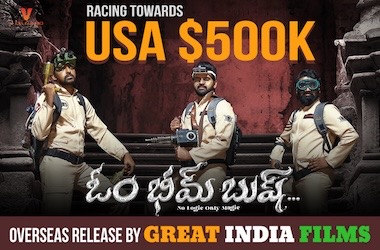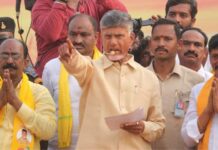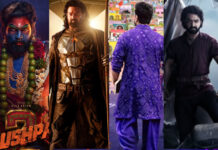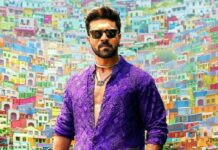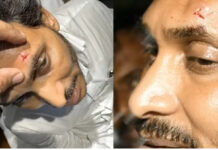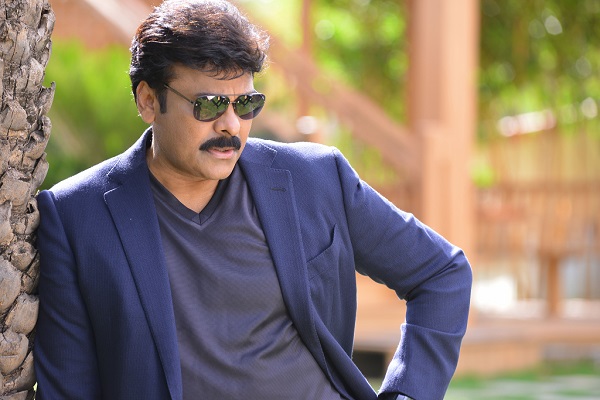
Sridhar Sattiraju details the fabulous story for Konidela Siva Sankara Vara Prasad to Megastar Chiranjeevi. In part 1, he details the nostalgic account of the Megastar’s journey through the 80s.
In Telugu, whenever somebody sneezes, the elders immediately wish “Chiranjeeva” and add at-least 100 years to live. Today, the Telugu film fans worldwide have celebrated the 60th birthday of a living legend who is called “Chiranjeevi” by screen name which has stuck on since 1978 as a phenomenon that will remain unrivaled for a long time. The chant for Chiru fans is for another sixty years more of long-life and happiness for the one and only Megastar.
For almost as long as Tollywood’s history, competition has always been intense between matinee idols of every generation – NTR and ANR, Krishna and Sobhan Babu and later, Krishnam Raju. In the late eighties, the competition was between stars like Nagarjuna and Venkatesh who almost burst open at the same time. Between 1999 and now, you have as many as a dozen stars or star sons who are fiercely competing with each other attempting to generate content that is slightly differentiated from each other. But for the period since 1978 – 2009, for thirty long years and more, there is only one actor-star Chiranjeevi who strode like a colossus and commanded maximum fan following and respect from the industry for a body of work that now completed 149 films which include special appearances and guest appearances including fleeting foot-movements in the movies of his son Ramcharan.
There has been no other actor like Chiranjeevi in Telugu film industry who rode as the monarch, without sharing limelight with another actor for shelf-space in so many generations, there has been an actor who built his brand equity one film at a time with an approach of a master sculptor as if he is sculpting a masterpiece by chiselling away bits and pieces of unwanted material. With every film that he acted in, Chiranjeevi ascended one level higher, except on few occasions, when he got carried away by mega success. Hitherto, most of the Telugu film heroes looked like surreal stars with card-board cutouts, awkward wigs, buttoned-down shirts and bell-bottom pants caught in their own imagined worlds of cosmetic beauty and unnatural heroism. Most of the male stars had makeups that shamed what their female counterparts used and didn’t know what mannerisms to use when sereneding their heroines on screen, they lacked the natural grace that heroism represents; the vanity vans also had their own partitions, the heroes had sky-high egos and the heroines danced in their own rhythms. There was no syncronisation in the dances of the hero and the heroine, the plots and the stunts looked like the heroes were reluctant to dirty their hands or fall on the ground for the sake of hitting the bad guys.
Chiranjeevi entered the films at exactly this point with few offbeat films when Telugu film industry had two generations of heroes already but there were dimensions of heroism waiting to be explored on screen – with more style, passion, panache and vigor. . He debuted in 1978 with Praanam Khareedu in which the main hero was Chandramohan. In the same year, he starred in Manavoori Pandavalu directed by Bapu, in which he neither had a heroine nor had the lead role like Murali Mohan or Prasad Babu (a batch mate of Chiru). Between 1978 and 1983, Chiranjeevi acted in fifty films, most of them low-budget productions. While K Vasu directed his first film Praanam Khareedu and Bapu his second film, it took an year or two more for him to get spotted by other leading lights like K Balachander for Idi Kadhakaadu (and later for Aadavallu Meeku Joharlu, 47 Rojulu), K Raghavendra Rao for Mosagadu, Katta Subba Rao for Mogudu Kaavali, V Madhusudhana Rao forChandipriya, Kodi Ramakrishna (for Intlo Ramayya Veedhilo Krishnayya) , K Vishwanath for Subhalekha, Vamsi for Manchupallaki before others like KSR Das, M Balaiah, A Kodandarami Reddy, Vijay Bapineedu, Ravi Raja Pinisetti, Bharatiraja, B Gopal and Jandhyala made films with Chiranjeevi as the hero.
Right from his debut in 1978, Chiranjeevi’s focus was on getting as much work as possible and hence did as many odd jobs as an aspirant could, taking roles distinctly diverse from each other, even as villain and as a character with negative shades. He played roles of a maniac (I love you), sadist (Idi Kadha Kaadu, 47 Rojulu), habitual liar (Kothalarayudu), cheat (Mosagaadu, Nakili Manishi), snake personality (PunnamiNagu), husband-on-hire (Mogudu Kaavali), rapist (Ranikasula Rangamma), rowdy (Kirayi Rowdilu), waiter (Subhalekha), villager (Patnam Vachina Pativratalu), unemployed youth (Manchupallaki), noted criminal (Billa Ranga) , a law-breaker (Chattaniki Kallu Levu) middle-class employee (Intlo Ramayya Veedhilo Krishnayya). Infact, the list of his first fifty movies within a span of five years may actually throw up a lot more occupations than what an actor in any generation could aspire for. It is the most-fulfilling body of work for any actor who wants to prove versatility of roles and subjects. In fifty films, you will find almost 42 different directors. This phase of his films, the first phase of his filmography has helped him make a statement that he can handle any roles without inhibitions, with style and a natural flair that never looked like a put-on. In a lot many of these films, he acted with some of the ruling stars like NTR, Krishna, Sobhan Babu, Krishnam Raju, Chandramohan, Murali Mohan, Mohan Babu and rubbed shoulders with actors who will become reigning actors of the current generation like Kamal Hassan and Rajinikanth.
The stage was set for Chiranjeevi to conquer new heights of stardom that he hasn’t yet tasted even though many of his films were getting talked about or hit the jubilee milestones. Movies like Manavoori Pandavalu, Tayaramma Bangarayya, Kotalarayudu, Mogudu Kavali, Nyayam Kavali, Chattaniki Kallu Levu, Kirayi Rowdilu, Intlo Ramayya Veedhilo Krishnayya, Subhalekha, Patnamvachina Pativratalu, Mondighatam became hits or superhits and this rank outsider who came with bit roles and differentiated characters criss-crossing the genres of thriller, spy, romance, tragedy, family drama, suspense, action, love story, revenge and crime story caught the attention of all kinds of cine-goers. Throughout this phase of Chiranjeevis films until almost his 68th film (Devanthakudu) , he took great care to groom his looks to match the needs of a Telugu audience growing up on the rebel decade of the eighties who have already started outgrowing the lover-boy, mytho-socio-historical trappings of ANR and NTR or the imperfect mannerisms of a cowboy-James Bond adapted to desi sensibilities like those of Krishna. Chiranjeevi also consciously avoided the bigamous story themes adapted by Sobhan Babu and Krishnam Raju on one side and the vast range of characters both of historical and socio-fantasy kind that will upset the established order of the day.
Unlike Superstar Krishna who went about ruffling the feathers of NTR and ANR in the attempts to remake improvised versions of the famous characters enacted by the legendary duo, Chiranjeevi wanted to create a unique footprint on Telugu cinema that made the best use of the moods of the young generation of the 80s as well as take the influences of Western films to adapt a totally fresh and bold body language anchored to Telugu sensibilities. This was also the time when Superstar Amitabh Bachchan started ascending to the top of Bollywood with angry young-man scripts. But Chiranjeevi took a lot of business from few stars in the 80s because of the superior range of acting skills and dancing perfections he had honed himself with, working with such perfectionists as Bapu, Vishwanath and Balachander – one was Krishna and the other was Chandramohan. Of course, the rebel star Krishnam Raju also felt the heat of Chiru’s onslaught. But the one who felt the most was Krishna because the action genre that Krishna relied on got bested when Chiranjeevi came to the scene. The few of the Bond and cowbody films that Chiranjeevi did were technically more brilliant and had the sophisticated body-language, stylish stunt movements and acting caliber that Krishna’s earlier films couldn’t portray despite their connectivity with the audience. Chiranjeevi’s rise in many ways brought down a quicker downfall for Krishna who had to find different subjects and rotate films.
A stark statistic proves a point here. In the year 1980, Chiranjeevi had 14 of his films released in one year. In another year circa 1980s, Krishna had over 18 films released suggesting that the competition intensified between themselves and their fan clubs. For a rank outsider, coming from Kapu community, Chiranjeevi soon became a sensational star who changed the way the industry was dominated by Kammas, as if it was their bastion. Of course, until 1986, Chiranjeevi never took on roles donned by NTR as the latter was already in serious politics by 1983. Neither titles of the films nor roles resembled anything close to what NTR did. But in 1986, he chose a title called Devanthakudu (which was an old NTR classic) to do a role resembling what NTR did called Yamagola which became a blockbuster in the heydays of Emergency in the late seventies. But for that and later Yamudiki Mogudu and later an unconventional remake of Raktasambhandam in the form ofLankeswarudu, Chiranjeevi never forayed into roles done by NTR and ANR.
Clearly, Chiranjeevi made fantastic capital from the emerging trends and fashions of the day and gained mileage and enormous traction in the films of the 80s- making remakes of famous Hollywood and Bollywood originals like Madmax (Yamkinkarudu), First Blood (Khaidi), Shaukeen (Premapichollu), Raiders of the Lost Ark (Hero), Witness (Pasivadi Pranam), Tarzan (Adavi Donga), Vijeta- Hindi (Vijeta- Telugu), Robin Hood (Kondaveeti Donga) and some inspired by martial arts films (Sivudu Sivudu Sivudu). There were some which sought to encase the Bond themes like (Gudhachari No.1). Movies like Billa Ranga, Abhilasha reflected Chiru’s desire to explore hot topics of the day. Despite many films celebrating silver and golden jubilee hits, the film Khaidi released in 1983 heralded the stardom of Chiranjeevi because it combined action, romance and a treatment by director Kodandarami Reddy like never before in a Telugu film used to immature action stories. Here was Chiranjeevi looking every inch as rugged and blood-stained as Sylvester Stallone and yet dancing with Madhavi in sensuous and skin-hugging comforts without inhibitions. The rest is history as they say and Chiru became the new-age cult hero of the masses. His box-office performance went from strength to strength since the film Khaidi was released and waned but a few times in his career ever since.
Another tipping point for Chiranjeevi was that he was open to new scripts and new producers (some of them even co-aspiring actors who never made it as big as him). Apart from friends and batchmates like Narayan Rao and late Hariprasad who collaborated to produce movies in which Chiru gave block dates (movies like Devantakudu, Yamudiki Mogudu), there was a famous YAKS tailors in Hyderabad who produced a film Dhairyavantudu with Chiranjeevi. This made Chiranjeevi a multi-dimensional star who had the momentum going for him – in novel adaptations (like those of Yandamoori Veerendranath which got made into blockbusters like Abhilasha, Challenge, Rakshasudu, Marana Mrudangam, Stuartpuram Police Station), mass films (Donga series like Donga, Adavi Donga, Donga Mogudu, Jebu Donga, Manchi Donga), experimental and off-beat films by acclaimed directors like Bharati Raja (Aradhana), Bapu (Mantrigari Viyyankudu), K Viswanath (Swayamkrushi), K Balachander (Rudraveena), Vamsi (Manchupallaki), Jandhyala (Chantabbai).
Of course, Chiranjeevi never went near historical and mythological characters except an occasional appearance as Lord Shiva here and there. Although, Chiranjeevi gave a chance to many producers like Creative Commercials, Aswani Dutt, T Subbarami Reddy, Kranti Kumar, Vijay Bapineedu, Edida Nageswar Rao, Satyanarayana, it is surprising that Allu Arvind and his combines have produced the most of Chiru’s films. But the fire to give different experience to his fans never went out of Chiru’s mind. In selecting his subjects, he always had a sum-of-parts approach to building his brand equity once he started tasting huge box office success. He infused new talent in cast and crew but never diluted the commercial elements of story-telling thereby creating huge fan-following with emphatic acting, stylish dance movements that syncronised with the body-language of the heroines (unlike most heroes who shake a leg without matching steps with the lady) and energetic dialogue delivery. In dancing, he became a non-pareil and fans drooled over his Jackson-like performances; infact, for a long time until the advent of the next-gen like NTR Jr. and Allu Arjun, Chiranjeevi was the numero uno in dancing.
Between 1988 and 1989, Chiranjeevi had 11 releases including the national-award winner Rudraveena which underscored his acting prowess trained by his early mentor K Balachander and Yamudiki Mogudu and Khaidi No.786 both of which tasted resounding success at the box office. The craze for his films was so huge that State Rowdy a film that was allegedly made by T Subbarami Reddy to “book” losses actually turned out to be a sleeper hit at the box office. Two other movies Attaku Yamudu Ammayiki Mogudu and Rudranetra released in 1989 were the sole hits while a much-awaited combination of Dasari Narayana Rao and Chiranjeevi – Lankeswarudu bombed. But by the end of the decade, Chiranjeevi’s star status leapfrogged to Megastar status. Only Amitabh Bachchan was occasionally being referred to in the same league as a Megastar but not as ubiquitiously as Chiranjeevi. With a staggering record at the box-office, turning out blistering hits, Chiranjeevi became the leading man in Telugu film industry outpacing everybody else – Krishna, Sobhan Babu, Balakrishna and Krishnam Raju. People were waiting for his films.
In the crucial years of build-out of his stardom in the 80s, Chiranjeevi’s dazzling range of films and repertoire of acting skills in inter-mixing genres of comedy, romance, sentiment and action have also helped him connect with the masses better. He found more informal ways of connecting with the masses and the fans, creating fan clubs, staying connected with remotest places in AP and surprising fans by visiting them at their homes. This created a different kind of euphoria for Chiranjeevi as a flesh-and-blood star who is grounded and accessible. With support form Allu Arvind and later his younger brother Nagababu, Chiranjeevi galvanised his close associates and family members to weave one of the most-organised fan network in the world over the last few decades. His fan clubs began small –and grew by leaps and bounds but later got galvanised into massive movements that helped the Megastar in many crucial run-ins with rival fan clubs.
Enter the 90s, two new movies projected Chiranjeevi in a never-before-seen swash-buckle. This was also the juncture when Chiranjeevi contemplated taking on Bollywood – because no South star tasted full-fledged commercial success at the box-office by themselves. Not Kamal Hassan and not Rajinikanth.


